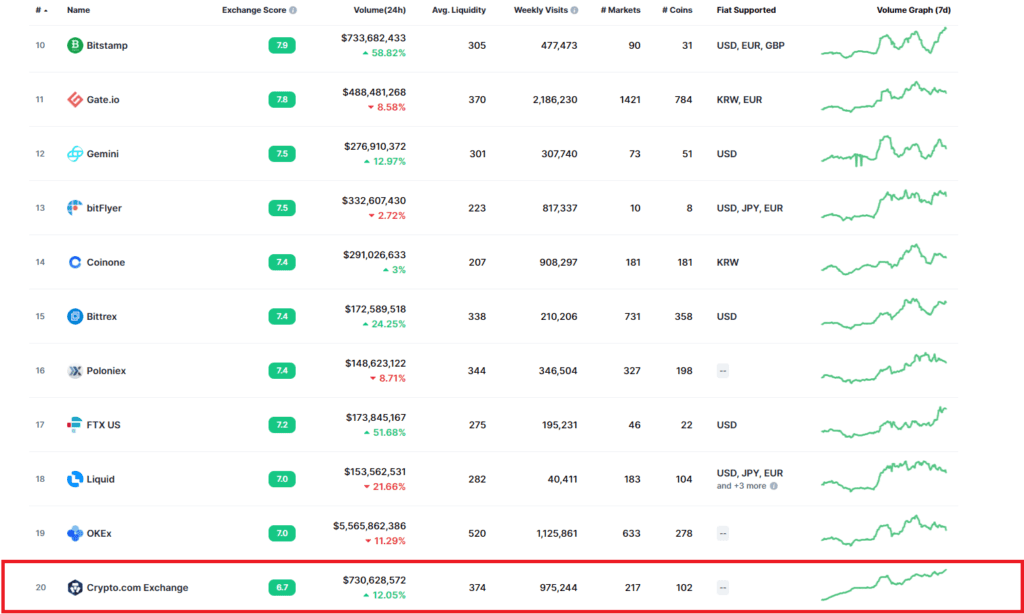Crypto.com is a Singapore-based cryptocurrency exchange and digital wallet that was founded in 2017 by the CEO of Monaco, Kris Marszalek. One of Asia’s most successful exchanges, Crypto.com has been in business for a long time.
Crypto.com recently launched its own blockchains, Crypto.com Chain and Cronos Chain, which will enable users across industries to securely access financial data from anywhere on any device.
The purpose of this article is to introduce everything you need to know about the native token (CRO) in the Crypto.com ecosystem.
What is Crypto.com? #
Crypto.com has been developing new features to suit the needs of investors from both the retail and corporate sides of the equation. It launched with spot trading capability and has been adding new features ever since. Users can trade cryptocurrency with ease on the exchange, and there are several advantages:
- Liquidity deep.
- Traders with high volumes can take advantage of competitive rates (after CRO staking discount).
- Syndicate organizes engaging events such as discounted token distributions.
- A fully resilient infrastructure powered by institutional-grade components.
 Crypto.com Exchange
Crypto.com ExchangeBesides the spot trading functionality, Crypto.com plans to release additional features so that both consumers and corporations can take advantage of a suite of cryptocurrency-related services.
As Crypto.com becomes an all-inclusive future service provider for crypto enthusiasts, its CRO liquidity and broad range of offerings make it stand out among other exchange platforms in this market space.
According to Coinmarketcap, the platform is currently among the top 20 centralized trading exchanges. With 975,244 weekly visits and $730 million in 24 hour trading volume, it is impressive.
 Crypto.com Marketcap (Coinmarketcap 13/08/21)
Crypto.com Marketcap (Coinmarketcap 13/08/21)Crypto.com’s Ecosystem #
Providing a decentralized solution to help revolutionize cross-border payments, Crypto.org Chain, scheduled for launch in March 2021, is the next-generation public blockchain that enables worldwide transactions between people and businesses.
This platform is also used for Crypto.com Pay, our mobile payment app that is extremely popular in Asia, and will soon be available globally.
Crypto.org Chain was created based on these propositions:
- Secure: The Chain is fault-tolerant and safe because it is designed this way;
- Instant & Low-Cost: Instant confirmation of transactions along with minimal fees;
- Permissionless: The Chain is an open-source project that is open to any party interested in joining the network and/or contributing to its development.
A token called CRO will serve as the utility coin for Crypto.com Chain, which includes payments, trading, and financial services.
Cronos Chain #
On 20th July 2021, the team released a new testnet of Cronos Chain. It is a decentralized, open-source public blockchain of Crypto.com built on top of the Cosmos SDK to provide a secure payment infrastructure for financial institutions around the world.
The Cronos blockchain aims to provide stability through the Ethereum Virtual Machine (EVM) while providing an interoperable sidechain to the Crypto.com Chain. This allows users to migrate their applications and smart contracts from EVM-compatible chains quickly and easily, based on the design of Cronos.
 Cronos Chain
Cronos Chain‘Cronos’ is a project to attract more users to Crypto.com’s native currency (CRO), across their ecosystem. In addition to payment and staking, CRO tokens also prove their validity through participation in the Cronos Defi ecosystem – all without introducing new tokens. Due to the development of Cronos, this coin will likely gain popularity in the near future.
What is CRO? #
Powered by Crypto.com Coin (CRO), a next-generation public blockchain platform, users will be able to power their crypto transactions and financial services in an innovative way. Payment solutions, trading features, and other components of the CRO ecosystem are all designed with user security in mind.
By using the CRO Token, Crypto.org Chain and Cronos Chain can provide advanced asset use cases like payments and peer-to-peer banking through smart contracts that are centered on user protection.